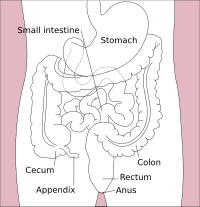Sigmoid colon
| Sigmoid colon | |
|---|---|
sacral nerve[1] | |
| Identifiers | |
| Latin | colon sigmoideum |
| MeSH | D012809 |
| TA98 | A05.7.03.007 |
| TA2 | 2987 |
| FMA | 14548 |
| Anatomical terminology] | |
 |
| Major parts of the |
| Gastrointestinal tract |
|---|
The sigmoid colon (or pelvic colon) is the part of the large intestine that is closest to the rectum and anus. It forms a loop that averages about 35–40 centimetres (14–16 in) in length. The loop is typically shaped like a Greek letter sigma (ς) or Latin letter S (thus sigma + -oid). This part of the colon normally lies within the pelvis, but due to its freedom of movement it is liable to be displaced into the abdominal cavity.[2]
Structure
The sigmoid colon begins at the
It then curves on itself and turns toward the left to reach the middle line at the level of the third piece of the sacrum, where it bends downward and ends in the rectum.
Its function is to expel solid and gaseous waste from the gastrointestinal tract. The curving path it takes toward the anus allows it to store gas in the superior arched portion, enabling the colon to expel gas without excreting faeces simultaneously.
Coverings
The sigmoid colon is completely surrounded by
Nerve supply
Pelvic splanchnic nerves are the primary source for parasympathetic innervation. Lumbar splanchnic nerves provide sympathetic innervation via the inferior mesenteric ganglion.
Relations
Behind the sigmoid colon are the
In front, it is separated from the
.Clinical significance
This section needs expansion. You can help by adding to it. (February 2014) |
Diverticulosis often occurs in the sigmoid colon in association with increased intraluminal pressure and focal weakness in the colonic wall. It is a common cause of hematochezia.
Volvulus occurs when a portion of the bowel twists around its mesentery, which can lead to obstruction and infarction. Volvulus in the elderly commonly occurs in the sigmoid colon, whereas in infants and children it is more likely to occur in the midgut. This may correct itself spontaneously or the rotation may continue until the blood supply of the gut is cut off completely.
Additional images
-
Iliac colon, sigmoid or pelvic colon, and rectum seen from the front, after removal of pubic bones and bladder
-
Sagittal section of the lower part of a female trunk, right segment
References
![]() This article incorporates text in the public domain from page 1182 of the 20th edition of Gray's Anatomy (1918)
This article incorporates text in the public domain from page 1182 of the 20th edition of Gray's Anatomy (1918)
- ^ Nosek, Thomas M. "Section 6/6ch2/s6ch2_30". Essentials of Human Physiology. Archived from the original on 2016-03-24.
- ^ Harkins, JM; Sajjad, H. "Anatomy, Abdomen and Pelvis, Sigmoid Colon". National Center for Biotechnology Information. StatPearls Publishing, Treasure Island, FL. Retrieved 31 January 2024.
External links
- Anatomy figure: 37:06-07 at Human Anatomy Online, SUNY Downstate Medical Center - "The large intestine."
- Superior & Inferior Mesenteric Artery at The Anatomy Lesson by Wesley Norman (Georgetown University)



